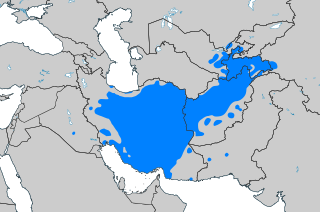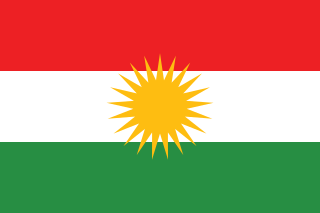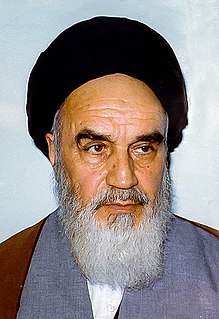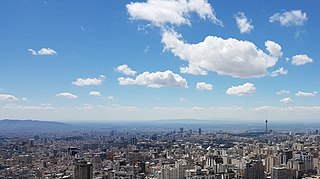
The Baháʼí Faith is a relatively new religion teaching the essential worth of all religions and the unity of all people. Established by Baháʼu'lláh in the 19th century, it initially developed in Iran and parts of the Middle East, where it has faced ongoing persecution since its inception. The religion is estimated to have over five million adherents, known as Baháʼís, spread throughout most of the world's countries and territories.

Persian, also known by its endonym Farsi, is a Western Iranian language belonging to the Iranian branch of the Indo-Iranian subdivision of the Indo-European languages. Persian is a pluricentric language predominantly spoken and used officially within Iran, Afghanistan and Tajikistan in three mutually intelligible standard varieties, namely Iranian Persian, Dari Persian and Tajiki Persian. It is also spoken natively in the Tajik variety by a significant population within Uzbekistan, as well as within other regions with a Persianate history in the cultural sphere of Greater Iran. It is written officially within Iran and Afghanistan in the Persian alphabet, a derivation of the Arabic script, and within Tajikistan in the Tajik alphabet, a derivation of the Cyrillic script.

Iran, also called Persia, and officially the Islamic Republic of Iran, is a country in Western Asia. It is bordered to the west by Iraq and Turkey, to the northwest by Azerbaijan and Armenia, to the north by the Caspian Sea and Turkmenistan, to the east by Afghanistan and Pakistan, and to the south by the Gulf of Oman and the Persian Gulf. Iran covers an area of 1,648,195 km2 (636,372 sq mi), making it the fourth-largest country entirely in Asia and the second-largest in Western Asia. Its population is 85 million, the 17th-most populous in the world. Its capital and largest city is Tehran.

The Iran–Contra affair, often referred to as the Iran–Contra scandal, the McFarlane affair, or simply Iran–Contra, was a political scandal in the United States that occurred during the second term of the Reagan Administration. Senior administration officials secretly facilitated the sale of arms to the Khomeini government of the Islamic Republic of Iran, which was the subject of an arms embargo. The administration hoped to use the proceeds of the arms sale to fund the Contras in Nicaragua. Under the Boland Amendment, further funding of the Contras by the government had been prohibited by Congress.

The Iran–Iraq War was a protracted armed conflict that began on 22 September 1980 with a full-scale invasion of Iran by neighbouring Iraq. The war lasted for almost eight years, and ended in a stalemate on 20 August 1988, when Iran accepted Resolution 598 of the United Nations Security Council. Iraq's primary rationale for the invasion was to cripple Iran and prevent Ruhollah Khomeini from exporting the 1979 Iranian Revolution movement to Shia-majority Iraq and internally exploit religious tensions that would threaten the Sunni-dominated Ba'athist leadership led by Saddam Hussein. Iraq also wished to replace Iran as the dominant state in the Persian Gulf, which, prior to the Iranian Revolution, was not seen as an achievable objective by the Iraqi leadership due to pre-revolutionary Iran's colossal economic and military power as well as its close alliances with the United States, a superpower, and Israel, a major player in the Middle East. The war followed a long-running history of bilateral border disputes between the two states, as a result of which Iraq planned to retake the eastern bank of the Shatt al-Arab ceded in 1975. Iraq supported Arab separatists in the oil-rich territory of Khuzestan seeking an Arab state known as "Arabistan" who had started an insurgency in 1979 with support from Iraq. Iraq sought to seize control of and sever Khuzestan from Iran. Saddam Hussein publicly stated in November 1980 that Iraq was not seeking annexation of Khuzestan into Iraq; rather, it is believed that Iraq sought to establish a suzerainty over the territory.

Kurds or Kurdish people are an Iranian ethnic group native to the mountainous region of Kurdistan in Western Asia, which spans southeastern Turkey, northwestern Iran, northern Iraq, and northern Syria. There are exclaves of Kurds in Central Anatolia, Khorasan, and the Caucasus, as well as significant Kurdish diaspora communities in the cities of western Turkey and Western Europe. The Kurdish population is estimated to be between 30 and 45 million.
The Persians are an Iranian ethnic group that make up over half the population of Iran. They share a common cultural system and are native speakers of the Persian language, as well as languages closely related to Persian.

Sayyid Ruhollah Musavi Khomeini, also known as Ayatollah Khomeini, was an Iranian political and religious leader who served as the 1st Supreme Leader of Iran from 1979 until his death in 1989. He was the founder of the Islamic Republic of Iran and the leader of the 1979 Iranian Revolution, which saw the overthrow of the last Shah of Iran, Mohammad Reza Pahlavi, and the end of the Persian monarchy. Following the revolution, Khomeini became the country's first supreme leader, a position created in the constitution of the Islamic Republic as the highest-ranking political and religious authority of the nation, which he held until his death. Most of his period in power was taken up by the Iran–Iraq War of 1980–1988. He was succeeded by Ali Khamenei on 4 June 1989.

Zoroastrianism or Mazdayasna is an Iranian religion and one of the world's oldest continuously-practiced organized faiths, based on the teachings of the Iranian-speaking prophet Zoroaster. It has a dualistic cosmology of good and evil and an eschatology which predicts the ultimate conquest of evil by good. Zoroastrianism exalts an uncreated and benevolent deity of wisdom known as Ahura Mazda as its supreme being. Historically, the unique features of Zoroastrianism, such as its monotheism, messianism, belief in free will and judgement after death, conception of heaven, hell, angels, and demons, among other concepts, may have influenced other religious and philosophical systems, including the Abrahamic religions and Gnosticism, Northern Buddhism, and Greek philosophy.

Tehran is the capital of Iran and Tehran Province. With a population of around 8.7 million in the city and 15 million in the larger metropolitan area of Greater Tehran, Tehran is the most populous city in Iran and Western Asia, and has the second-largest metropolitan area in the Middle East, after Cairo). It is ranked 24th in the world by metropolitan area population. It is also known for its sprawling development and futuristic architecture, epitomized by the Milad Tower and the Fereshteh Pasargad Hotel, designed by Zaha Hadid.

The history of Iran, which was commonly known until the mid-20th century as Persia in the Western world, is intertwined with the history of a larger region, also to an extent known as Greater Iran, comprising the area from Anatolia in the west to the borders of Ancient India and the Syr Darya in the east, and from the Caucasus and the Eurasian Steppe in the north to the Persian Gulf and the Gulf of Oman in the south.

The Medes were an ancient Iranian people who spoke the Median language and who inhabited an area known as Media between western and northern Iran. Around the 11th century BC, they occupied the mountainous region of northwestern Iran and the northeastern and eastern region of Mesopotamia located in the region of Hamadan (Ecbatana). Their consolidation in Iran is believed to have occurred during the 8th century BC. In the 7th century BC, all of western Iran and some other territories were under Median rule, but their precise geographic extent remains unknown.
Iran national football team, recognised by FIFA as IR Iran, represents Iran in international football and is controlled by the Football Federation Islamic Republic of Iran (FFIRI). Between December 2014 until May 2018, Iran was the highest-ranked team in Asia, the longest continuous period of time that a team has held that distinction.

The Iranian Revolution, also known as the Islamic Revolution was a series of events that culminated in the overthrow of the Pahlavi dynasty under Shah Mohammad Reza Pahlavi, and the replacement of his government with an Islamic republic under the rule of Ayatollah Ruhollah Khomeini, a leader of one of the factions in the revolt. The revolution was supported by various leftist and Islamist organizations.

Sayyid Ali Hosseini Khamenei is a Twelver Shia Marja' and the second and current supreme leader of Iran, in office since 1989. He was previously the third president of Iran from 1981 to 1989. Khamenei is the longest serving head of state in the Middle East, as well as the second-longest serving Iranian leader of the last century, after Shah Mohammad Reza Pahlavi.

Iran is subdivided into thirty-one provinces, each governed from a local centre, usually the largest local city, which is called the capital of that province. The provincial authority is headed by a Governor-general, who is appointed by the Minister of the Interior subject to approval of the cabinet.

Carlos Manuel Brito Leal de Queiroz, ComIH, is a Mozambican-Portuguese football coach who is currently the manager of the Egypt national team. He has served as the manager of his native Portugal's national team on two occasions, the United Arab Emirates, South Africa, Iran and Colombia, leading South Africa (2002), Portugal (2010) and Iran to the FIFA World Cup. At club level, he has also managed Sporting CP, the New York/New Jersey Metrostars in Major League Soccer and Spanish club Real Madrid. He also had two spells as Alex Ferguson's assistant manager at English club Manchester United.

The Iranian peoples or Iranic peoples are a diverse grouping of Indo-European peoples who are identified by their use of the Iranian languages and other cultural similarities.

Mohammad Reza Pahlavi, also known as Mohammad Reza Shah, was the last Shah (King) of the Imperial State of Iran from 16 September 1941 until his overthrow in the Iranian Revolution on 11 February 1979. Due to his status as the last Shah of Iran, he is often known as simply the Shah.

Aryan or Arya is a term originally used as an ethnocultural self-designation by Indo-Iranians in ancient times, in contrast to the nearby outsiders known as 'non-Aryan' (*an-arya). In Ancient India, the term ā́rya was used by the Indo-Aryan speakers of the Vedic period as an endonym (self-designation) and in reference to a region known as Āryāvarta, where the Indo-Aryan culture emerged. In the Avesta scriptures, ancient Iranian peoples similarly used the term airya to designate themselves as an ethnic group, and in reference to their mythical homeland, Airyanem Waēǰō. The stem also forms the etymological source of place names such as Iran (*Aryānām) and Alania (*Aryāna-).
















